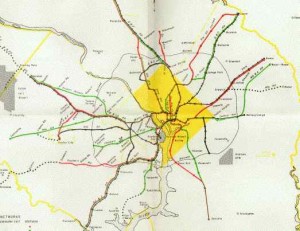Metro’s Planning, from the Beginning
In 1967, the Washington Metropolitan Area Transit Authority was created under a 1966 interstate compact encompassing the District of Columbia and portions of the State of Maryland and Commonwealth of Virginia, for the purpose of planning, financing, constructing, and operating a comprehensive mass transit system for the Washington Metropolitan Region. According to Article VI of the Compact the Board shall develop and adopt, and may from time to time review and revise, a mass transit plan for the immediate and long-range needs of the compact region.
The Compact guided the development of the original Adopted Regional System (ARS) in 1968, designed to serve the region as forecast for 1990. Zachary M. Schrag, author of The Great Society Subway, hosts a website including maps and photos of the ARS, as well as an historical account of the building of Metrorail. As planning and engineering continued over the next 20-plus years, the ARS was reviewed and revised, consistent with the Compact. By the mid-1990s, planning had been completed for the ARS. Metro began to look at transit needs beyond those for which the original system had been planned, and to look at a much larger region, as forecast for 2025. Metro’s latest long-range system plan — the Transit Service Expansion Plan— was adopted in 1999.
The Transit Service Expansion Plan was put forth as a contribution to an improved transportation planning process and to a coordinated regional transportation solution. The plan responded to the transportation system solutions that were identified by various regional groups and embraced the goals and objectives identified in the Metropolitan Washington Council of Governments Transportation Planning Board Vision Plan.
At the time of adoption, the Board of Directors endorsed three main long-term goals for the role of public transit services:
- “The region must commit to doubling transit ridership by 2025 in order to maintain transit market share and to enhance its contribution to mobility and accessibility, to improved air quality, to reduced traffic congestion, and to serving increased regional growth and travel demands.
- Major transportation corridors and the regional transportation system must include a significant transit element that complements and effectively utilizes the region’s roads and bridge system by connecting major commercial, retail, entertainment and residential activity centers and transportation facilities in a way which ensures that the region remains economically viable and competitive in the world market place.
- Public transportation must be envisioned as an essential means to support and enhance community livability and quality of life.”
From your perspective, in the past 10+ years, has the region’s transit system (including Metrorail, Metrobus, local bus and commuter rail) done what has been needed in terms of contributing to mobility and accessibility, serving the region’s growth, and enhancing the region’s livability and economic vitality?
Future posts will document the progress-to-date on the implementation of the 1999 plan, so stay tuned…



Recent Comments